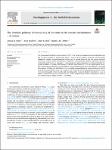The intrinsic primary bioreceptivity of concrete in the coastal environment – A review
| dc.contributor.author | Bone, JR | |
| dc.contributor.author | Stafford, R | |
| dc.contributor.author | Hall, AE | |
| dc.contributor.author | Herbert, RJH | |
| dc.date.accessioned | 2023-11-23T13:06:26Z | |
| dc.date.available | 2023-11-23T13:06:26Z | |
| dc.date.issued | 2022-05 | |
| dc.identifier.issn | 2666-1659 | |
| dc.identifier.issn | 2666-1659 | |
| dc.identifier.other | 100078 | |
| dc.identifier.uri | https://pearl.plymouth.ac.uk/handle/10026.1/21687 | |
| dc.description.abstract |
The proliferation of artificial concrete structures (ACSs) in the marine environment causes intertidal habitat loss and is a poor surrogate for natural rocky shores in terms of species richness, abundance, and community composition. As hard engineered coastlines increase, there is growing interest in how new concrete structures can facilitate improved habitat and biodiversity compared to existing concrete structures. Experiments that have substituted cement binder and aggregates in varying proportions and combinations have demonstrated that it is possible to enhance the primary bioreceptivity of concrete, either chemically or via microtopographical texture. This review synthesises key literature and identifies which concrete formulas prove most effective at enhancing bioreceptivity and those that have limited value, providing recommendations for coastal practitioners and for formulas that warrant further study. It is evident that the efficacy of chemical bioreceptivity of concrete is likely to be spatio-temporally limited (months) and enhancing surface roughness should be prioritised as a way to enhance colonisation. However, both chemical and physical methods require further investigation in within in situ marine settings for longer durations (>12 months). | |
| dc.format.extent | 100078-100078 | |
| dc.language | en | |
| dc.publisher | Elsevier BV | |
| dc.subject | 4005 Civil Engineering | |
| dc.subject | 40 Engineering | |
| dc.subject | 33 Built Environment and Design | |
| dc.subject | 3302 Building | |
| dc.subject | 14 Life Below Water | |
| dc.title | The intrinsic primary bioreceptivity of concrete in the coastal environment – A review | |
| dc.type | journal-article | |
| dc.type | Review | |
| plymouth.volume | 10 | |
| plymouth.publication-status | Published | |
| plymouth.journal | Developments in the Built Environment | |
| dc.identifier.doi | 10.1016/j.dibe.2022.100078 | |
| plymouth.organisational-group | |Plymouth | |
| plymouth.organisational-group | |Plymouth|Faculty of Science and Engineering | |
| plymouth.organisational-group | |Plymouth|Faculty of Science and Engineering|School of Biological and Marine Sciences | |
| plymouth.organisational-group | |Plymouth|Users by role | |
| plymouth.organisational-group | |Plymouth|Users by role|Academics | |
| dcterms.dateAccepted | 2022-04-21 | |
| dc.date.updated | 2023-11-23T13:06:19Z | |
| dc.rights.embargodate | 2023-11-24 | |
| dc.identifier.eissn | 2666-1659 | |
| rioxxterms.versionofrecord | 10.1016/j.dibe.2022.100078 |


